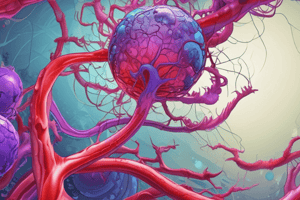Podcast
Questions and Answers
Specific proteins can be identified using immunofixation electrophoresis.
Specific proteins can be identified using immunofixation electrophoresis.
True (A)
Proteins are first reacted with a specific antibody and then separated by electrophoresis.
Proteins are first reacted with a specific antibody and then separated by electrophoresis.
False (B)
The antibody-protein complex is washed away while other proteins remain in the gel.
The antibody-protein complex is washed away while other proteins remain in the gel.
False (B)
Enzyme-linked immunosorbent assay (ELISA) is used to quantify the serum levels of specific antibodies.
Enzyme-linked immunosorbent assay (ELISA) is used to quantify the serum levels of specific antibodies.
ELISA can be used both to diagnose current infection and to confirm the presence of immunity.
ELISA can be used both to diagnose current infection and to confirm the presence of immunity.
Immunofixation electrophoresis is used to quantify serum levels of specific antibodies.
Immunofixation electrophoresis is used to quantify serum levels of specific antibodies.
Enzyme immunoassays can be used to identify specific proteins.
Enzyme immunoassays can be used to identify specific proteins.
In enzyme immunoassays, proteins are separated and quantified.
In enzyme immunoassays, proteins are separated and quantified.
Immunofixation electrophoresis involves reacting separated proteins with a specific antibody.
Immunofixation electrophoresis involves reacting separated proteins with a specific antibody.
Enzyme-linked immunosorbent assay (ELISA) is used to identify proteins by binding with specific antigens.
Enzyme-linked immunosorbent assay (ELISA) is used to identify proteins by binding with specific antigens.
Flashcards are hidden until you start studying
Study Notes
Plasma Proteins
- Plasma consists of water, electrolytes, metabolites, nutrients, proteins, and hormones.
- Plasma protein concentration is approximately 7.0-7.5 g/dL.
- Plasma proteins comprise around 7% of plasma by weight and 0.5% of total body mass.
Functions of Plasma Proteins
- Maintenance of plasma osmotic pressure, mainly by albumin.
- Transport functions of lipids, hormones, metals, and excretory products.
- Defense reactions by immunoglobulins.
- Coagulation and fibrinolysis by thrombin and plasminogen.
- Buffering of H+ ions.
- Protease inhibitors by α1-antitrypsin and α2-macroglobulin.
- Enzymes as renin, coagulation factors.
- Complement proteins (C3 & C4) protect the body from infections.
Types of Plasma Proteins
- Albumin
- Globulins
- Fibrinogen
- Others: hundreds of protein molecules.
Plasma Protein Abnormalities
- Beta fraction: subdivided into two peaks, beta-1 and beta-2.
- Beta-1 zone: transferrin and low-density lipoprotein (LDL).
- Beta-2 zone: complement proteins (C3 & C4).
- Elevated beta-2 zone: caused in inflammatory states due to activation of complement cascade.
Albumin
- Synthesized in the liver, accounts for around 55% of plasma protein.
- Typical reference range: 35-55 g/l, with no reserve or storage.
- Maintains osmotic pressure of plasma and functions in transport of various substances.
- Four binding sites on albumin, with varying specificities for different substances.
- Glycated albumin: a more sensitive indicator of short-term hyperglycemic control.
Prealbumin
- Transport protein for thyroxine and triiodothyronine (thyroid hormones).
- Binds with retinol-binding protein to form a complex that transports retinol (vitamin A).
- Rich in tryptophan.
- Decreased in hepatic damage, acute-phase inflammatory response, and tissue necrosis.
- Low prealbumin level: a sensitive marker of poor nutritional status.
- Increased in patients receiving steroids, in alcoholism, and in chronic renal failure.
Alpha Fraction
- Alpha-1 peak: alpha-1 antitrypsin, an acute-phase reactant.
- Alpha-1 antitrypsin: increased in conditions of inflammation and decreased in patients with alpha-1 antitrypsin deficiency.
- Alpha-2 peak: alpha-2 macroglobulin, haptoglobin, and ceruloplasmin, which are acute-phase reactants.
- Alpha-2-macroglobulin: increased in nephrotic syndrome.
- Haptoglobin and ceruloplasmin: increased in acute inflammatory states.
Gamma Fraction
- Last zone comprises immunoglobulins (IgG, IgA, IgM, IgE, IgD).
- Hypergammaglobulinemia or gammopathies: increased serum gamma globulin levels.
- Gammopathy: abnormal proliferation of lymphoid cells producing immunoglobulins.
- There are four types of gammopathies: polyclonal, monoclonal, biclonal, and oligoclonal.
- Hypogammaglobulinemia: decreased serum gamma globulin levels, manifested by frequent infections.
Immunofixation Electrophoresis and Enzyme Immunoassays
- Specific proteins can be identified using immunofixation electrophoresis.
- In these tests, proteins are first separated by electrophoresis and then reacted with a specific antibody.
- The antibody-protein complex remains in the gel while other proteins are washed away, allowing the protein to be identified and quantified.
- Enzyme-linked immunosorbent assay (ELISA) used to quantify the serum levels of specific antibodies.
- Used to diagnose current infection and to confirm the presence of immunity.
Studying That Suits You
Use AI to generate personalized quizzes and flashcards to suit your learning preferences.




